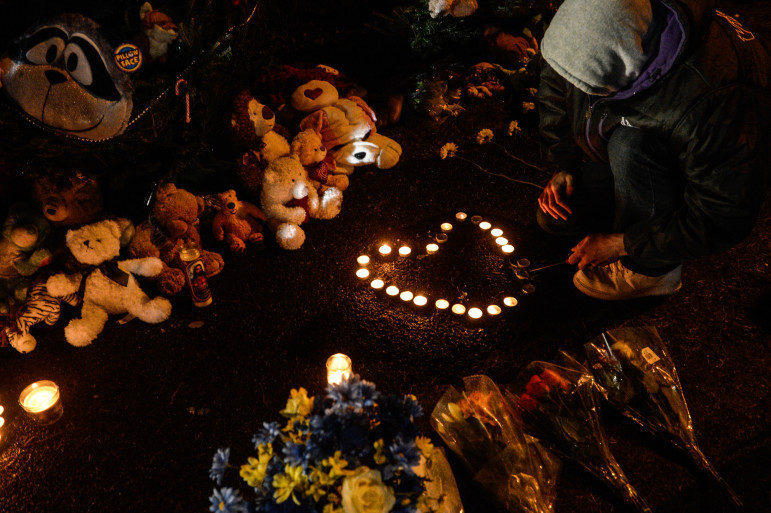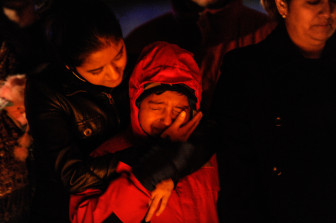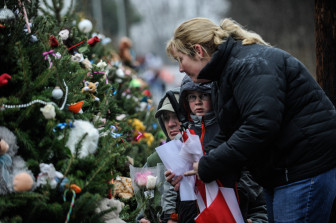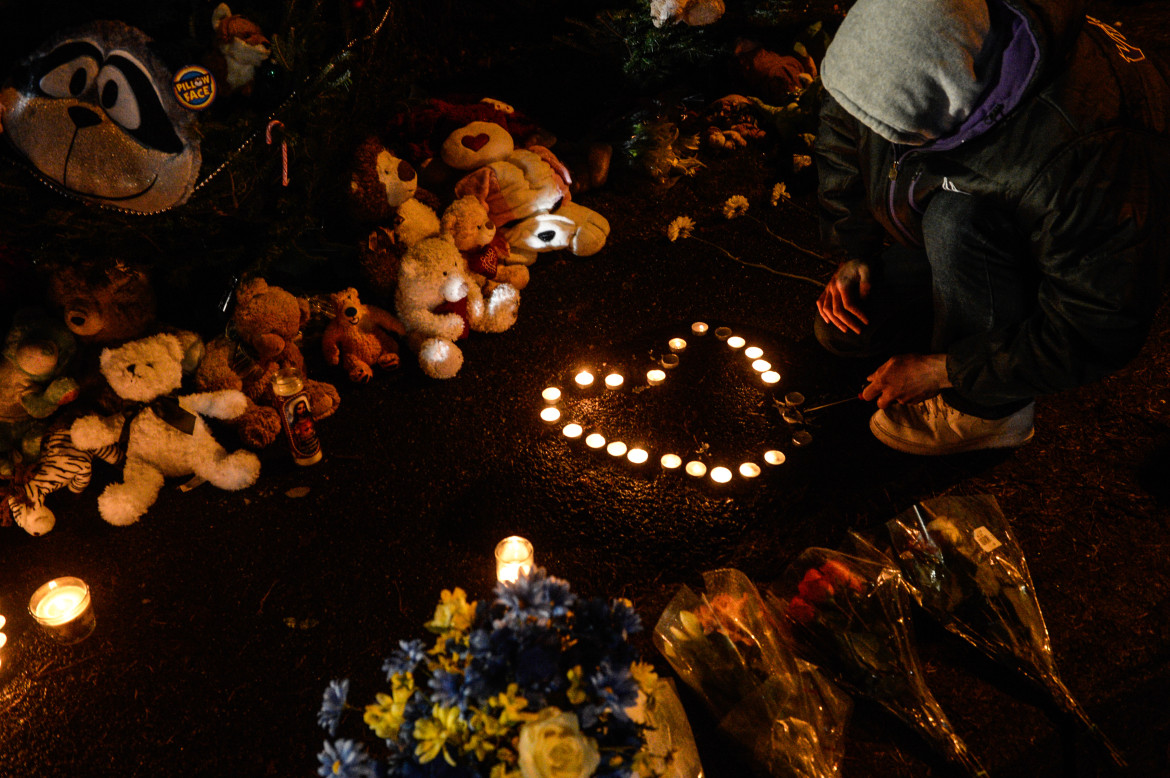
Robert Stolarik / The New York Times
Newtown, Connecticut.
There’s a stretch of road in Newtown, Connecticut, 524 paces long. It leads from the official town Christmas tree at the corner of Riverside Drive and Washington Avenue up a hill and down again to a soft bend in the road at Dickinson Court where a sign hangs from a wooden post decorated with curling back wrought-ironwork that reads:
Sandy Hook School
1956
Visitors Welcome
There, next to a staging area for emergency workers and police investigators, sits a sprawling memorial to the 20 children shot and killed by a young man who was barely an adult himself.
Law enforcement officials are still piecing together what happened that morning, but for now they say that Adam Lanza, 20, after killing his mother and armed with an assault rifle and some handguns shot and his way into the Sandy Hook School. He killed six staff, 20 children, and then himself.
What used to be a nondescript road that connected the struggling heart of this small central Connecticut town to a municipal building has been transformed into an almost sacred path divided by a long line of orange emergency cones.
Without instruction, thousands of visitors from all over Connecticut, the country, and the world made the same silent pilgrimage between these two poles of grief. Their sympathy took on an almost childlike expression as adults with an incongruous solemnity, placed grinning stuffed animals under the town tree, or down the hill in piles creating a sprawling memorial shielded from a cold rain by two crooked orange tents.

Robert Stolarik / The New York Times
They stopped to stare at the burgeoning memorials. Some prayed. Some wept. Some collapsed on the wet ground in a heap.
It was difficult for many of the visitors, tourists inexorably drawn to the small town not for its stores or quaint architectural facades but because of its tragedy, to articulate why they were there. They asked how it could happen? Why? They talked about big questions.
“It’s unfathomable this kind of evil,” said Father Jack Whritenour, 42, a father of a school age daughter and the pastor of Trinity Lutheran Church in the town of Shelton, 15 miles south of Newtown. “It’s an age-old question and it doesn’t have any easy answers.”
From Anguish to Answers
 But even as Whritenour spoke President Barack Obama was en route to Sandy Hook and he was about to give a policy-driven shape to the massacre which had prompted so much raw emotion. On the Sunday after the shooting at the Sandy Hook interfaith prayer vigil at Newtown High School, President Obama put mental health care reform squarely at the center of the debate over how to respond to the mass shooting, the fourth to occur under his administration:
But even as Whritenour spoke President Barack Obama was en route to Sandy Hook and he was about to give a policy-driven shape to the massacre which had prompted so much raw emotion. On the Sunday after the shooting at the Sandy Hook interfaith prayer vigil at Newtown High School, President Obama put mental health care reform squarely at the center of the debate over how to respond to the mass shooting, the fourth to occur under his administration:
“In the coming weeks, I will use whatever power this office holds to engage my fellow citizens -- from law enforcement to mental health professionals to parents and educators -- in an effort aimed at preventing more tragedies like this. Because what choice do we have? We can't accept events like this as routine. Are we really prepared to say that we're powerless in the face of such carnage, that the politics are too hard? Are we prepared to say that such violence visited on our children year after year after year is somehow the price of our freedom.”
In the wake of the Sandy Hook shooting everyone from mental health care workers to lawyers to advocates, to people who are working in the mental health care system or have dedicated their lives to reforming it have said it has sparked a conversation like nothing any of them have ever seen in this country. The discussion about reforming what they describe as a broken system for delivering mental health care to people who need it, particularly children and teens, has been robust.
They said it’s unclear what Adam Lanza’s history with the mental health care system was, and they don’t know what diagnosis or treatment, if any, he ever received. But, they said, the shooting has had average citizens and the politicians who represent them asking hard and thoughtful questions about what can be fixed in the system to minimize the risk of the kind of incidents that cost 20 first graders, six school staff and the gunman’s mother their lives and devastated a New England town.
“We need to wake up and say enough,” said Darcy Gruttadaro, the director of the Child and Adolescent Action Center at the National Alliance on Mental Illness. “This is a different dialogue than we’ve had in the past. I think it’s the age of the victims, it’s the holiday season, people are tired of the guns, it’s the realization that we have a broken mental health care system in this country. It’s the only razor thin silver lining in this tragedy. There’s no silver lining for the families of victims, but this is a moment where real change can happen and reduce the possibility of what happened in Newtown happening again in another small town. I think people have had enough.”
Among the problems that the experts hope are fixed in the wake of the Newtown shooting are changes in the law to make it easier for people who are in crisis to get help, increasing programs in schools to identify children with mental health problems, developing the programs to intervene and get the children help, developing incentives to get more professionals into pediatric psychiatric care and helping families with children with mental illnesses feel less like they are alone.
“I don’t fall into the camp that we shouldn’t talk about violence right now,” said a pediatric mental health worker who has worked in Connecticut. “I hope people are going to have an even more in depth discussion. Even though this is a terrible tragedy it has dredged up a lot of problems. I think it’s an opportunity to talk about what we can do to make a change in health care for families dealing with mentally ill children. The reality is that once you’re dealing with a really sick kid your whole life has to change. And psychiatric services suck with insurance.”
“Thank God We’re Poor”

Robert Stolarik / The New York Times
In her career, the mental health worker has worked for high-end pediatric psychiatric services that refuse to accept insurance and community clinics who see people on Medicaid. She said more than once she’s had to explain to people that they’re not poor enough to get treatment. She said she’s seen people bankrupt themselves to get care for a mentally ill child. And she also has told parents living in poverty how thankful they should be that they can get care for their children.
She said it was a running joke at the clinic she worked at: Thank God we’re poor.
That’s because some states like New York and Connecticut have progressive mental health treatment plans for people on Medicaid, but that the cutoff is extremely low.
In New York a family of four needs to make no more than $15,208 annually; and in Connecticut it’s $40,000. Medicaid provides about half of state mental-health budgets, experts say.
“You have to be so poor,” she said. “Some people I would consider poor can’t get Medicaid, even when they’re in crisis.”
She said once a child is admitted to a hospital with a mental illness there’s a lot of pressure to get him out because private insurance is so paltry in their coverage. She said she worked with a psychiatrist who had a teen patient who was hospitalized for being suicidal, but who had private insurance. The accountant responsible for monitoring costs would come down and ask whether or not the child was still suicidal because their coverage only lasted one more day.
“What was surprising to me about Connecticut, from working on both ends of the spectrum, is that I never once worked with patients from my own demographic,” said the middle income mental health worker. “I never had clinical placement with anyone who was like me. They were either millionaires or so poor.”
Problems in Another Connecticut Town
In another sleepy Connecticut town known for its wealth, and like Newtown, celebrated as a tight-knit community where everyone knows everybody, there’s a boy sleeping with a knife under his pillow. He’s worried that his older brother is going to come in one night and try to harm him. Down the hall there’s a divorced mother who gave up on treatment for her son, and instead has memorized a safety plan drawn up by mental health professionals in case he does something worse than just break her nose next time.
The mental health care worker, who asked to remain unnamed, spent nine months working with the family and trying to reach the 16-year old boy, but she said it didn’t work. She said he was one of the most difficult patients she’s ever worked with. The worker said she remembered having conversations with the boy’s mother.
“She was petrified of her son,” she said. “This mother was like ‘What do I do? I’m scared of my child.’ And what do you do? Aside from sending him to some wilderness camp what can you do? He doesn’t technically meet the criteria for hospitalization. He was crafty enough to hide his behavior from one of us. He was all smiles, meanwhile the poor mom is telling me she can’t be home alone with him because he is threatening to hurt me.”
The mother said the problem is compounded by her son’s high school. She placed calls repeatedly to officials at the public high school, one with a good reputation in the state, asking that they take the initiative in disciplining her son. She begged the administration, the mental health care worker said, to fail her son out of the classes where he was not performing well, but they rebuffed her. The mother told the school officials that her son was a time bomb. They passed him to the next grade anyway.
“She tried everything she could but it’s a wealthy school district that didn’t want to admit that they had a problem child,” the mental health worker said. “I even made calls to the school to get some collateral, but it didn’t make any difference.”
The mental health care worker recounts one incident that illustrated the frustration the mother felt at the seeming inability to do anything to get her son help. On a home visit, she met with the mother in the living room. The mother had explained to her that her troubled son had recently punched her in the face after she told him he wasn’t allowed to buy a bacon, egg and cheese sandwich every morning before going to school.
The mental health care worker visited to discuss the incident. The mother and son were sitting on the couch, the father was looming over the mental health care worker. She said he was not supportive of the therapy. When she asked the boy about what he did to his mother, she said what the teenager said was chilling.
“Broken nose,” he said with a shrug. “Or a bacon, egg and cheese sandwich? You decide.”
Experts said this is not an unusual example of what a lot of families are struggling with. They say without early identification and intervention, a teenager like this feels more isolated from his family. He never had the opportunity, they say, to learn how to deal with their symptoms and how to interact with their families.
So often, families get frustrated with the system; they expect things to get better faster and when they don’t they give up, leaving themselves isolated and saddled with a sense of helplessness.
“It’s not unusual, whether its someone on the autism spectrum or suffering a mental illness that they’re suffering from isolation,” Gruttadaro said. “Our concern here is that there’s family education and support available so that these families don’t feel like they’re all alone.”
A New Massacre, the Same Question
Another impediment, some experts say, is the laws in some states that have such a high threshold for what meets the standard to get mentally ill people off the streets and into a hospital or clinic.
“The problem with the law in New York and Connecticut is that people have to be violent and suicidal. You have to be about to hurt yourself or someone else to be taken as a serious threat. That’s what it takes to get treatment in New York and Connecticut,” said Brian Stettin, the policy director at the Treatment Advocacy Center and a lawyer who specializes in the New York Metropolitan area.
He said after massacres he is plagued by the same question.
“The first thing we wonder about after dealing with the initial horror is, ‘Was Adam Lanza one of ours,’” he said. “Someone with a severe illness who couldn’t get treatment because he was too ill to agree to treatment.”
On Jan. 3, 1999 Andrew Goldstein, 29, a man diagnosed with schizophrenia who was later found to be off his medication, shoved a journalist, Kendra Webdale, 32, onto the train tracks of an oncoming N train at the 23rd Street subway station. After that incident, then Attorney General Eliot Spitzer was looking for a way to change the law to get the mentally ill into treatment before they did something violent. He tasked Stettin with the job. Stettin drafted a bill that would eventually be known as Kendra’s Law.
The law allows judges to require people like Goldstein to regularly undergo mental health treatment. If the mentally ill person refuses or fails to attend the treatment, it grants the judge the authority to commit the person for up to 72 hours.
Stettin said after drafting the law, he visited Kendra’s mother, Patricia Webdale in Buffalo to ask her permission to name the law after he daughter. Since then, he said, he has devoted his professional life to reforming the mental health care system.
“If we can identify a person who is on the road to becoming dangerous, even if they haven’t reached that point yet, that’s the key to getting help to people to avoid tragedies like this in Newtown,” he said. “We don’t know if this would have prevented Adam Lanza from doing what he did, but we do know that this type of tragedy would happen less frequently if we were determined to get people treatment in a timely fashion.”
Intervening Before the Next Crisis
Experts and workers agreed that one of the central problems, even before delivering care, is identifying those who need it. The problem experts and mental health workers say is that there are a number of impediments to identifying people who are mentally ill and intervening on their behalf. The impediments start when the mentally ill person is still a child.
“We don’t do a good job of intervention, we don’t do a good job at early intervention,” Gruttadaro said. We wait for the crisis to happen to act and then it’s too late. We need to screen for mental health problems in the schools, we need a system that can deliver quality care to teens and children across the country, we need to screen children in a healthcare setting and we’re not doing that -- we’re waiting too long.”
She and others agree that is vital to get the money necessary to develop programs that identify children with mental illness sooner rather than later and pursue what she calls a “wrap around” approach that links the schools and the mental health community. But that can’t happen until the massive gap between the need of pediatric care professional is closed.
Gruttadaro said there are 7500 child psychologists in the country with a need of 20,000.
“You have a lot of kids who can’t see someone who are in a serious condition,” she said. “They get a diagnosis and then they get added to a three to six month waiting list. We need to get a workforce that can meet the needs of these kids.”
When they don’t get the treatment, a lot of the mentally ill end up getting substandard care in prisons and jails. They either slip through the cracks by not receiving treatment at a young age, or their illness drives them to act out and get arrested. According to the Bureau for Justice Statistics, 56 percent of state prisoners, 45 percent of federal prisoners and 64 percent of jail inmates had mental health problems in 2006.
The biggest warehouse for the mentally ill in New York City is Rikers Island. A lawyer who works with the Rikers population there said one third of the inmates receive mental health treatment, a rate three times that of the non-jailed population. Of that inmate population, one quarter are found to suffer from a “serious and persistent mental illness” by the city.
“What Difference Does It Make”
As night fell the Christmas trees, one for each slain child, their names written in black marker on little silver stars fashioned from silver foil, begin to sag from a day of rain. Without the context, the scene seemed like an idyll of Christmas morning in a small town. Fresh evergreens loaded with presents beneath their fragrant branches. All the visitors who made the grim pilgrimage had loaded the trees with so many well-meaning tokens of affection that the trees could barely hold them up anymore.
A toy wedged in a branch fell with a wet thud on the muddy grassy below. All but one flame in a heart arranged out of tealight candles flickered. Now that President Obama had delivered his speech at the Sandy Hook interfaith prayer vigil at Newtown High School the crowds had thinned. A marching band of teenagers emerged from the gloom and made the procession from the Christmas tree to the staging area. As the band, playing a mournful tune out of time, marched along the path a state trooper asked where they were going.
His colleague shrugged and replied: “I don’t know. What difference does it make?”
